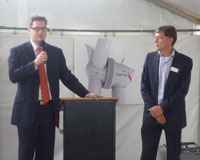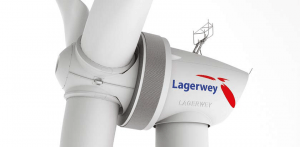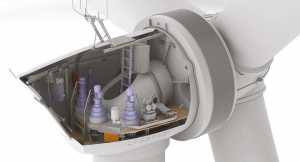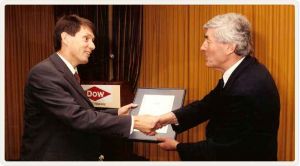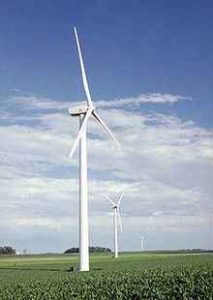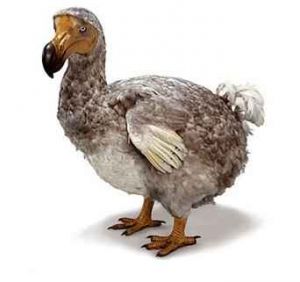Introduction
While the world of wind power may have its fair share of superb businessmen, entrepreneurs, innovators and “movers & shakers” there can be few whose career in wind has been as interesting as Henk Lagerweij (seen on the right in the pictire above receiving certification for the L82 turbine). He is the Dutch whizz-kid and wunderkind whose fortunes, like the wind, have blown both hot and cold, and varied in strength from becalmed to storm force with all the points inbetween.
The Beginning
Lagerweij’s first brush with the wind, was in fact much more than a brush; more like being totally wind-swept. Born on Bernveld he witnessed, on his doorstep, the storm of November 15, 1972. Thousands of trees were blown to the ground and he first became aware of the power of the wind. He began to think whay one might be able to do with the wind. As the son of a farmer he was aware of the use farmers make of windmills- and of course the traditional view of the Dutch is of a country full of dykes, canals, clogs, tulips, and of course, windmills. Lagerweij’s enquiries led him to discover that many of his neighbors around the farm had their own windmills to generate energy as long ago as World War II. Obviously these were simple affairs compared to today’s giant turbines.
Lagerweij began building his first prototype wind turbines when he was still at Polytechnic studying electronics. After completing his studies, he worked in the former wind group of the Technical University of Eindhoven. It was clear already that he had been, as he says in his own words, “caught with the wind” and was being blown on a course to greater things…
First Company
In 1979, just seven years after that fateful storm, Henk Lagerweij created his own Dutch wind turbine company; Lagerweij en Van de Loenhorst, with his brother-in-law . The timing was perfect- the middle of the second global oil crisis. Right from the start his designs had innovative features: He was the first to produce variable speed wind turbines with passive blade pitch control to limit the rotor speed. Additionally he was at the forefront of developing the benefits of flexible rotor structural design to decrease the loading. Unsurprisingly, many succesful types of turbines were designed and manufactured.
Buoyed along by the encouragement of the Dutch Governemnt to develop wind power when oil-generated electricity was so expensive, Lagerweij and his brother-in-law developed a 15 kW turbine. In 1982 he sold about 20 of these, mainly to farmers and eco-warriors anxious to show off green credentials. In addition the company developed a twin turbine and then a six-rotor turbine (later reduced to four) with generators on one tower. The idea here was to harvest more wind from one tower in one place. Rather than increasing the size of the rotor diameter, which technically was difficult for the firm, smaller turbines were combined into multi-turbines.
Bankruptcy
Two years after the oil crisis, oil prices fell to a low point. Sales of wind turbines fell away. In 1985 the company went bankrupt having sold about 60 turbines in total. Lagerweij’s feelings of customer loyalty made him want to continue. “Luckily people started to realise then that wind energy needed some support to survive,” he says. “The accident with the nuclear power plant at Chernobyl also helped. That sort of meant the end of the nuclear alternative.” As a result money became available for developing wind power expertise and new prototypes and the Dutch Department of Economic Affairs started thinking about supporting investment in wind energy.
Waxing and Waning Fortunes
Despite this blow, and another bakruptcy to follow, Lagerweij continued to innovate and didn’t lose his passion for wind; following the two-bladed LW10/35 and the superb follow-up the LW18/80, (see below) in 1994 he introduced the LW30/250 with a 30 metre rotor. But two years later came a real breakthrough with the LW50/750, a gearless three-bladed with synchronous generator. Then came the stablishment of Lagerwey Wind BV (2006). Looking back the LW18s hav become legendary and some are still in operation even today. Lagerweij ran into financial trouble when on top of funding an ambitious R&D program, the firm was forced to carry out repairs on a large number of LW 750 units sold in Japan.
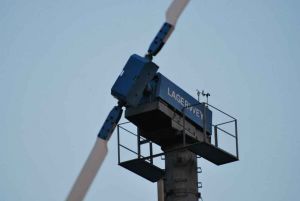
In 2009 the first L82-2MW was put into operation in Germany, followed by India. In 2012 2 units of the L93-2.6MW were put in operation in Lelystad in the Netherlands. There have been a number of other installations and developments in the past 4 years, as Lagerweij consolidates the firm’s position and as the two bankruptcies in the past become just a faded memory.
A lot has been happening for this year (2013) for Largerwey Wind. Two L100 turbines are being built for farmers at Lelystad, Netherlands. This will be a total turnkey solution. A developer in Finland Kaskisten,Tuulivoima Oy, has signed a long-term partnership with Lagerwey and established a new company Lagerwey Finland Oy and a number of wind farms are being planned powered by the latest Lagerwey turbines.
A Lagerwey sales office has been established in Ireland, and it is expected that following orders, new constructions will begin next year. The company are currently also working on a 4MW turbine.
What’s clear is that Henk Lagerweij is a man you can’t keep down- having bounced back for the second time, he’s learnt from the past and is determined to sustain his success this time! He’s come on a long journey from that storm in 1972- and there’s a long way to travel yet I think…
Below Lagerweij (left) receives the Dow Chemical award from former Dutch prime minister Ruud Lubbers.

